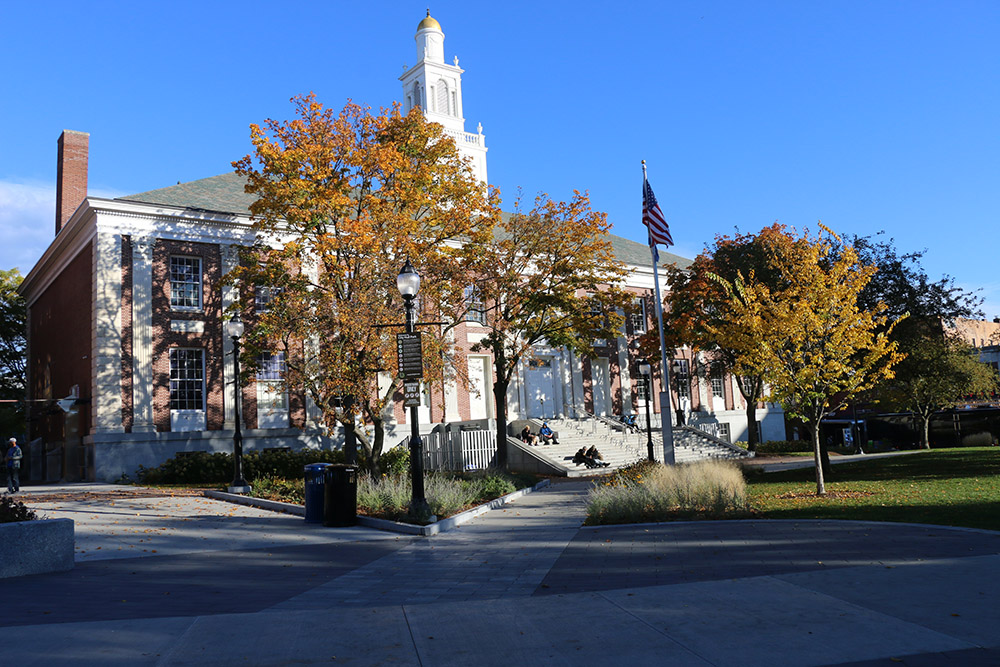Police Chief says lack of officers is to blame, city councilman disagrees

By Dakota Thomas
News Editor
dthomas4@mail.smcvt.edu
Devin Deets ’24 had been working his night shift at Red Square when he witnessed a shooting in Burlington this summer. He escorted people inside and they waited for dispatch to arrive.
“I got to see a lot and I had to do a lot, and that kind of put me in a weird headspace lately. That’s kind of why I haven’t been working much at night. I like to just work during the day now,” Deets said.
Gun violence in Burlington has risen this year, with 25 incidents reported as of Oct. 18. This year, Burlington has experienced four homicides and 13 shootings, to which someone had been wounded or killed from a firearm. According to the 2021 Downtown Safety Survey, conducted by the City of Burlington Street Marketplace, 53% of respondents reported feeling unsafe or “very unsafe” in Downtown Burlington at night.
The rise in crime prompted the Bureau of Alcohol, Tobacco, Firearms and Explosives (ATF) and Burling[1]ton Police Department to create the Chittenden County Gun Violence Task Force. The task force is expected to investigate and enforce, rather than complete legislative work, said John Murad, Burlington Chief of Police, in an interview with The Defender.
In 2020, there were 45,222 firearm-related deaths in the United States, according to the Centers for Disease Control and Prevention (CDC). In Chittenden County, the issue has grown exponentially since 2020. This is an unprecedented surge, as the number of gunfire incidents between 2012-2019 averaged only two per year. In June 2020, a resolution was passed at a City Council budget meeting to decrease the Burlington police force by 30% through attrition. City Council proposed this plan in light of both COVID-19 and the murder of George Floyd, but officers resigned at a faster rate than anticipated.
Murad explained that a lack of police officers in the Burlington Police Department has played a role in the rise of gunfire incidents. Despite new public safety positions within the department, including community support officers and liaisons in response to a request from the city council to separate policing and social work, he said these remedies don’t alleviate the pressure of a reduced workforce.
“In essence, to reduce the police force by that amount was somewhat equivalent to just turning it off and not having anything to replace it,” Murad said. While the overall call volume is down, priority one calls (calls requiring immediate response) are rising– with September having the highest volume of calls in one month since 2012.
The decreased police presence is noticed by local residents as well. Robert Cattanach ’23 is also an employee at Red Square, and agrees that a dwindling police presence has contributed to the number of gunfire incidents this year. “I feel like there’s a correlation between that and the rise in crime,” he said. After a recent incident that resulted in calling the police, he learned that only two police officers had patrolled Burlington that night. “It feels… insufficient for that population,” Cattanach said.
Burlington Mayor Miro Weinberger sent a newsletter to Burlington residents last week to address public safety concerns. “Prior to 2020, Friday nights would have up to 21 non-supervisory officers available with half of those stationed on foot in the Downtown,” Weinberger said in the newsletter. “Today, the department has 62 officers total, of which only 22 are available for patrol. At most times, only two to three officers are available for patrol for the whole City.”
Murad said that until over a month ago, about half of the gun violence in the past two-and-a-half years was committed by young men from the New American community. According to Murad, less than a dozen people are involved in gun violence crimes. For years, some members of these groups have been involved in repeated police interactions, he said, but efforts have always been to off-ramp these behaviors. Efforts for divergence through family court or record expungement works for some, but there’s a lack of incentive to change behaviors. “There’s a core group of people that do bad things as youth, and have all of these lack of consequences,” Murad said.
Joe Magee, city councilman for Burlington’s Ward 3, disagrees with Murad’s explanation for the rise in crime. Magee said the way to counteract this violence is to invest in prevention measures and make sure basic needs are met.
“Systems that were broken before the pandemic broke worse since the pandemic,” Magee said. The overlapping crisis between lack of affordable housing and the rising cost of living are also at play. He added that solutions require advocating for crisis response teams and policing alternatives to address these systemic issues at play, without relying too much on police presence and incarceration.
This is a very different approach than what was recommended by Mayor Weinberger. “We need more arrests, we need more incarceration,” Weinberger said in a press conference after the homicide in City Hall Park. “That is what needs to happen now. It’s not where any of us want this to end up. It does represent on some levels a community failure that we’ve gotten to this point,” he said.
Magee has been committed to exploring alternatives that focus on community support over punitive measures. Magee said that the emphasis on punitive measures, rather than restorative justice models, is a failed model “I’m seeing that same failed approach [punitive measures] here in Burlington, so what I would really like to see is some leadership for the mayor’s administration on engaging the community on what prevention looks like,” Magee said.
Magee stated conflicting approaches from city council and the Mayor’s office have been frustrating. “The resolution taken in 2020 [ to reduce police presence] was a community-wide understanding. I felt that we have to… radically change how we approach public safety in the city, and since then it’s been a gradual sort of unraveling of the work and the lack of commitment to it,” he said. He also recommended civilian oversight of the police.
Gun safety regulations are also a scope of this conversation. While Vermont has some of the most lenient gun regulations in the country, according to U.S. Concealed Carry Association. There is a connection between gun violence and access to firearms. According to the Giffords Law Center, Vermont has no law restrictions on machine guns, except for hunting. “Red flag laws,” or in Vermont’s case, extreme risk-protective orders, are laws that allow the courts to immediately remove firearms from citizens that are deemed to be a threat to the safety of themselves and others. Lack of restrictive gun laws stem from most of Vermont’s gun ownership being for rural usage. In the past, most firearms registered in the state have been rifles used for hunting or farming. However, recent firearms that have been confiscated were either stolen or diverted (unauthorized users and unauthorized uses of weapons according to the United Nations Organization).
“How do we, as a society, go about letting people know that we feel differently about [gun violence] , and we want to disincentivize it? And we want to say, this is a prohibition, something you don’t turn to and we recognize as different.” Murad said. With 400 million guns present in the United States, Murad added that trying to ban or move them is an unrealistic solution to the problem. Burlington Business Association created the Safety Escort Program over the summer. These safety escorts are focused on being a resource for retail and nightlife workers walking home late at night.
Weinberger released another newsletter on Saturday, addressing public safety concerns and new changes to improve police visibility this month. “Through at least the month of October, the green and gold uniforms of the VSP [Vermont State Police] will be a much more common sight on Church Street and in City Hall Park,” he said

